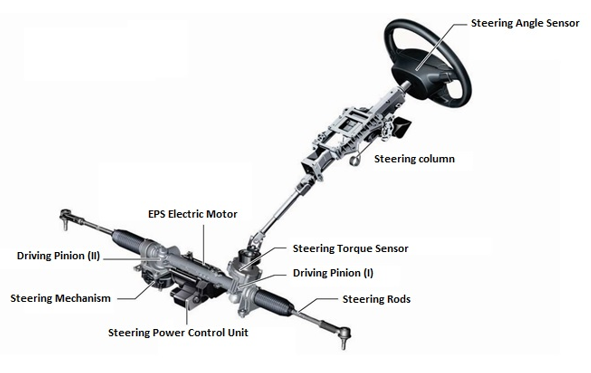How to Solve Eps Problem in Car
To solve an EPS problem in a car, first, check the EPS fuse and connectors for any issues. If the problem persists, have a professional diagnose and repair the EPS system.
Having a functioning Electronic Power Steering (EPS) system is crucial for the safe operation of your vehicle. However, encountering issues with the EPS can be a cause for concern. We will explore how to effectively address EPS problems in your car, ensuring optimal performance and safety on the road.
By following the simple steps outlined below, you can troubleshoot and resolve EPS issues efficiently. Let’s dive into the details of identifying, diagnosing, and fixing EPS problems in your vehicle.

Credit: m.youtube.com
Identifying Eps Problem
When it comes to solving EPS problems in your car, the first step is to identify the issue accurately. Being able to recognize the symptoms and using diagnostic tools will help you pinpoint the root cause of the problem, saving time and money on unnecessary repairs. In this guide, we’ll focus on how to identify EPS problems and the common symptoms associated with them.
Common Symptoms
Identifying the symptoms of EPS problems in your car can help you take appropriate action. Here are some common signs to look out for:
- Steering Difficulty: Experiencing difficulty in turning the steering wheel, especially at lower speeds.
- Noisy Steering: Unusual noises such as squeaking or whining when turning the steering wheel.
- Dashboard Warning Lights: Illumination of the EPS or power steering warning light on the dashboard.
- Inconsistent Steering Assist: Inconsistent or unpredictable steering assistance, making the steering feel heavy or loose at different times.
Diagnostic Tools
Utilizing diagnostic tools can aid in identifying EPS problems accurately. Some common diagnostic tools used to diagnose EPS issues include:
- Scan Tools: These tools can communicate with the car’s computer system to retrieve error codes and data related to EPS malfunctions.
- Power Steering Pressure Tester: A pressure tester can help measure the hydraulic pressure in the power steering system to identify any irregularities.
- Electronic Steering Torque Sensor Tester: This tester can check the electronic steering torque sensor for any malfunctions or irregular readings.
Eps Problem Causes
One of the common causes of EPS problems in cars are electrical issues.
Another frequent reason for EPS problems are mechanical issues within the system.
Fixing Eps Problem
Experiencing issues with your car’s Electronic Power Steering (EPS) system can be frustrating, but with a few simple troubleshooting steps, you can often resolve the problem without the need for expensive repairs. Understanding how to fix the EPS problem can help you maintain optimal performance and safety on the road.
Resetting The System
If you notice irregular steering behavior, try resetting the EPS system to recalibrate and potentially eliminate any glitches causing the issue. To do this, turn off the engine, wait for a minute, then restart the car to see if the problem persists.
Checking Wiring Connections
Inspect the wiring connections related to the EPS system for any signs of damage or loose connections. Make sure all wires are securely connected and free from corrosion, as faulty wiring can disrupt the system’s functionality.
Replacing Faulty Components
If resetting the system and checking the wiring connections do not resolve the EPS problem, consider replacing faulty components such as the EPS sensor or control module. Consult your car’s manual or a professional mechanic to identify and replace any malfunctioning parts.

Credit: m.youtube.com
Preventing Eps Problem
Avoiding a potential EPS (Electric Power Steering) problem is essential for maintaining the safety and performance of your car. By implementing regular maintenance and practicing safe driving habits, you can prevent EPS issues and ensure a smooth driving experience.
Regular Maintenance
Regular maintenance is crucial in preventing EPS problems in your car. Make sure to schedule routine inspections and servicing with a qualified mechanic. Ensure that the power steering fluid is checked and topped up as needed to keep the system running smoothly. Additionally, regularly inspect the steering components for any signs of wear or damage to address potential issues early.
Safe Driving Practices
Implementing safe driving practices can go a long way in preventing EPS problems. Avoid harsh and abrupt turns or manoeuvres that can put excessive strain on the EPS system. Maintaining a proper alignment and rotating your tires regularly can also contribute to the overall health of the steering system. Furthermore, be mindful of road conditions and avoid driving over potholes and other obstacles.
Seeking Professional Help
The EPS (Electric Power Steering) system is an essential component in a car, providing smooth and effortless steering. However, like any other mechanical system, it is prone to issues and malfunctions. When you encounter an EPS problem in your car, seeking professional help is crucial to ensure the problem is accurately diagnosed and resolved. Consulting a skilled mechanic who specializes in EPS systems can save you time, money, and potential further damage to your vehicle. In this section, we will discuss when to consult a mechanic and how to choose the right one for your specific needs.
When To Consult A Mechanic
When you experience significant changes or issues with your car’s steering, it is advisable to consult a mechanic. Some common signs that indicate the need for professional assistance include:
- Difficulty in turning the steering wheel or increased effort required
- Unexpected steering wheel vibrations
- Steering wheel not returning to its neutral position
- Strange noises coming from the EPS system
- Dashboard warning lights related to the EPS system
If you notice any of these signs, it is crucial not to delay seeking professional help. Ignoring EPS problems can lead to safety hazards and further damage to your car.
Choosing The Right Mechanic
When it comes to resolving EPS issues, it is essential to choose a mechanic who is experienced and knowledgeable in dealing with such problems. Here are a few factors to consider when selecting the right mechanic for your needs:
- Look for a mechanic who specializes in EPS systems or has experience working on modern car electronics.
- Ask for recommendations from friends, family, or trusted car enthusiasts who have had positive experiences with a particular mechanic.
- Check for certifications and qualifications that demonstrate the mechanic’s expertise in handling EPS systems.
- Consider the mechanic’s reputation and customer reviews to gauge their reliability and credibility.
- Inquire about the mechanic’s diagnostic capabilities and equipment to ensure they have the necessary tools for accurate troubleshooting.
By taking the time to choose a qualified and competent mechanic, you can have peace of mind knowing that your EPS problem will be diagnosed and resolved effectively.

Credit: servicems.eu
Frequently Asked Questions On How To Solve Eps Problem In Car
How Do I Fix Eps In My Car While Driving?
If you’re experiencing EPS issues while driving, here’s what you can do: 1. Safely pull over and turn off the engine. 2. Check if there’s any visible EPS damage or loose connections. 3. Restart the car and see if the issue persists.
4. If it continues, drive cautiously to the nearest mechanic for professional assistance.
How Do I Reset My Car Eps?
To reset your car EPS, locate the EPS fuse, remove it for 30 seconds, and then replace it. If the issue persists, contact a certified technician for further assistance.
Can Eps Be Repaired?
Yes, EPS can be repaired by patching or filling cracks and using specialized repair kits.
What Causes The Eps Light To Come On?
Common causes of the EPS light coming on include a faulty power steering system, low power steering fluid, or a malfunctioning steering angle sensor.
Why Is The Eps Light On In My Car?
The EPS light is on in your car because there is a problem with the Electronic Power Steering system.
What Causes The Eps Problem In Cars?
The EPS problem in cars can be caused by issues with the power steering pump, steering angle sensor, or wiring.
How Can I Diagnose The Eps Problem In My Car?
To diagnose the EPS problem in your car, you can use a diagnostic tool to read the error codes and check the components of the EPS system.
Conclusion
Resolving EPS problems in a car is crucial for safety and performance. By understanding common issues and implementing proper maintenance, drivers can ensure their electronic power steering system functions effectively. Regular inspections and prompt repairs are essential for preventing costly damage.
With these strategies, you can tackle EPS problems efficiently and enjoy a smooth driving experience.


